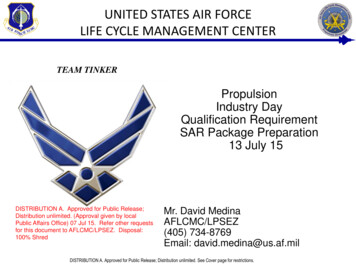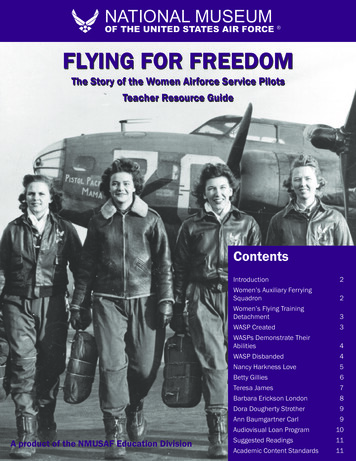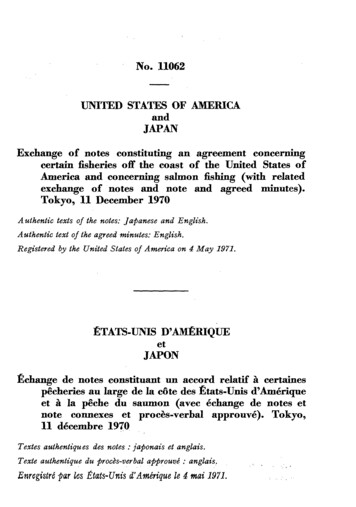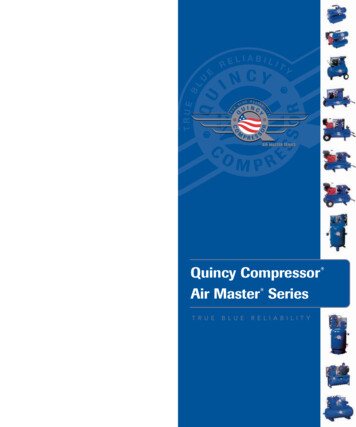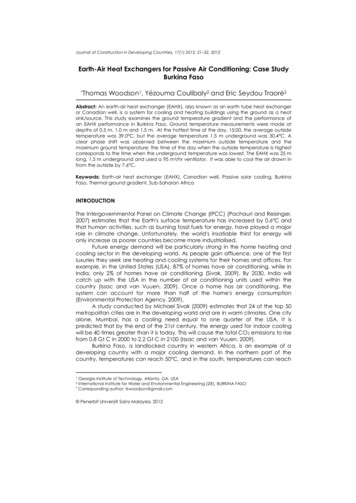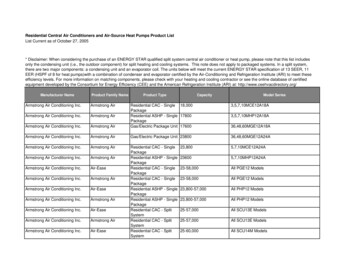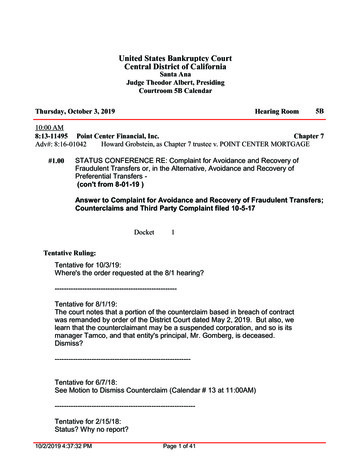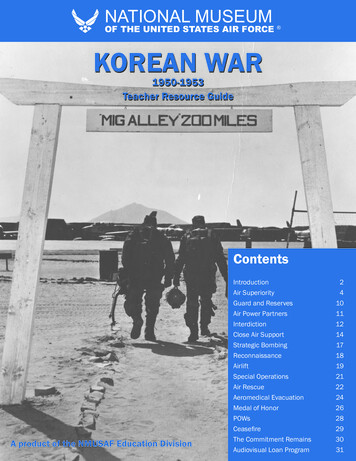
Transcription
NATIONAL MUSEUMOF THE UNITED STATES AIR FORCE KOREAN WAR1950-1953Teacher Resource GuideContentsA product of the NMUSAF Education DivisionIntroductionAir SuperiorityGuard and ReservesAir Power PartnersInterdictionClose Air SupportStrategic BombingReconnaissanceAirliftSpecial OperationsAir RescueAeromedical EvacuationMedal of HonorPOWsCeasefireThe Commitment RemainsAudiovisual Loan Program24101112141718192122242628293031
KOREAN WARAn Introduction“The Air Force is on trial in Korea.”- Gen. Hoyt S. Vandenberg, USAF Chief of Staff,1950The U.S. Air Force was only three years old as aseparate service when North Korea invaded SouthKorea in the summer of 1950. The next three yearsbrought significant changes in technology, roles andtactics, marking the beginning of the modern AirForce.When World War II ended, the United States accepted the surrender of the Japanese in Korea southof the 38th parallel, while the Soviet Union acceptedthe Japanese surrender north of that line. Although thewestern Allies intended that Korea become an independent democracy, the Soviet Union had other plans.In 1947 the United States put the problem of Korean independence before the United Nations. Whenthe UN ordered free elections throughout the country,the Soviet Union refused to allow them in the north.Free elections in the southern half of Korea in May of1948 established the Republic of Korea. The Sovietscreated a rival communist government in the north,the “People’s Democratic Republic of Korea.”With governments established in both halves ofKorea, the Soviets announced their intention to leavethe country and challenged the United States to do thesame. After training a small national force for internalsecurity in South Korea, the United States departed,leaving only a few military advisors. In the north, theSoviets oversaw the creation of the well-trained andequipped North Korean People’s Army with Soviettanks, heavy artillery and aircraft. After assuring themilitary superiority of North Korea, the Soviets left in1949. Less than a year later, border skirmishes between north and south exploded into all-out war withthe North Korean invasion of South Korea on June25, 1950.U.S. and UN RolesThe United States was committed to defendingSouth Korea against communist aggression. Althoughthe United States had no official treaty obligatingit to South Korea, President Harry Truman orderedU.S. forces in the Far East into action on June 27, andthree days later authorized air attacks in North Korea.He also began to mobilize reserves for the comingbattles.The Korean crisis was also the first major test forthe five-year-old United Nations. On June 25, 1950,the United Nations Security Council met to addressthe crisis. The Soviet Union, boycotting the UN because the international body did not recognize communist rule in China, did not attend. On June 27, theU.S. proposed the UN intervene in Korea with armedforce. With the Soviets absent and unable to veto themeasure, the resolution passed. In addition to SouthKorea and the U.S., 15 other member nations sentmilitary forces to stop the communist attack.K-Bases in KoreaThe USAF had numerous air bases in Korea, andmany of these were former Japanese airfields. Thespelling of Korean locations on maps varied greatly,and villages had a Korean and a Japanese name. A“K” number identified individual air bases in bothnorthern and southern Korea to prevent confusionamong locations.K-1 Pusan WestK-2 Taegu No. 1K-3 PohangdongK-4 SachonK-5 TaejonK-6 PyongtaekK-7 KwangjuK-8 KunsanK-9 Pusan EastK-10 ChinhaeK-11 UlsanK-12 MuanK-13 SuwonK-14 KimpoK-15 MokpoK-16 Seoul (Yongdungpo)K-17 OnginK-18 Kangnung (Koryo)K-19 Haeju (Kaishu)2 Visit www.nationalmuseum.af.mil for lesson plans and more(continued on next page)
(Introduction continued)Presentation availableK-20 SinmakK-21 PyonggangK-22 Onjong-niK-23 PyongyangK-24 Pyongyang EastK-25 WonsanK-26 SondokK-27 YonpoK-28 Hamhung WestK-29 SinanjuK-30 SinuijuK-31 Kilchu (Kisshu)K-32 Oesicho-dongK-33 Hoemon (Kaibun)K-34 Chongjin (Seishin)K-35 Hoeryong (Kainsei)K-36 Kanggye No. 1K-37 Taegu No. 2K-38 WonjuK-39 Cheju-do No. 1K-40 Cheju-do No. 2K-41 ChungjuK-42 Andong No. 2K-43 KyongjuK-44 Changhowon-niK-45 YojuK-46 HoengsongK-47 ChunchonK-48 IriK-49 Yangsu-riK-50 Sokcho-riK-51 InjeK-52 YangguK-53 (not completed)K-54 (not completed)K-55 Osan-niK-56 (not completed)K-57 KwangjuThis information is also available in a PowerPoint presentation. View the table of contents at ment/AFD-111229005.pdf and visit ment/AFD-111229-004.ppt to download thepresentation.The Korean climate was one of extremes, fromthe humid summer heat to the bitter winter cold.Dust, Mud and Snow: An Airman’s Life in KoreaLife on the K-bases remained fairly basic throughout the Korean War. USAF personnel generally livedin tents with wooden or concrete floors and storedtheir meager possessions in furniture cobbled togetherfrom scrap wood or crates. These tents were blisteringhot in the summer and freezing cold in the winter.(continued on next page)This photo of K-9 (Pusan East) in June 1953 showsa typical Korean air base at the end of the war.There are temporary corrugated metal buildingsin the middle, while on the right are tent barracks.The B-26 aircraft on the left are parked in the open,exposed to the elements.Register online for upcoming educational programs 3
(Introduction continued)The vast unpaved areas on air bases were dusty whendry, and they turned to mud with spring rains. Whileair crews did their best to fight boredom between tension-filled missions, maintenance personnel workedlong hours in poor weather conditions to keep wornand damaged aircraft in service.Army Green to Air Force BlueAfter the U.S. Air Force became a separate servicein 1947, it created new blue uniforms. Even so, AirForce personnel during the Korean War continuedto wear U.S. Army uniforms from existing stocks,including the famed “pinks and greens” clothing and“crush cap” hats from World War II. In some cases,Airmen wore a combination of Army green and AirForce blue uniforms.For the enlisted, yellow Army rank chevrons werereplaced with silver Air Force stripes. Another notable change was the renaming of some enlisted ranksThe varied uniforms illustrate the USAF in transitionduring the Korean War. Some wear the old uniformof the USAAF while others wear newly issued USAFblues or a combination of both.in 1952—The Army ranks of private and corporalbecame “Airman.”An interesting result of this uniform change wasthe nickname “brown-shoe Air Force.” The old Armyuniform had brown shoes, while the new Air Forceblue uniform had black shoes. So, “brown-shoe AirForce” referred to the old U.S. Army Air Forces or toa person who had served in the USAAF.Air Superiority: Controlling the Sky“As it happened, the air battle was short and sweet.Air supremacy over Korea was quickly established.”- Lt. Gen. E. George Stratemeyer, Far East AirForces Commander during the first year of warControlling the skies over Korea was the USAF’sprimary mission. After defeating the small NorthKorean Air Force, USAF pilots were challenged byAll-weather F-82G fighters at an air base in Japan.The USAF was forced to base some of its fighterunits in Japan when communist forcesoverran South Korean bases in 1950 and 1951.Soviet—and later Chinese and North Korean—pilots in nimble, swept-wing MiG-15 jets. The winningcombination of the F-86 Sabre and experienced USAFpilots, however, ensured UN ground forces need notfear the enemy’s air power.In Korea, the air superiority fight reflected the endof propeller-driven fighters and the supremacy of jetaircraft. At the beginning of the war in June 1950,the USAF Far East Air Forces had the piston-engineF-51D Mustang, the all-weather F-82 Twin Mustang,and the jet-propelled, straight-winged F-80 ShootingStar. Skilled USAF pilots overwhelmed the inexperienced pilots of the North Korean Air Force (NKAF),who were equipped with about 140 World War II-erapiston-engine aircraft.After defeating the NKAF, UN air forces enjoyed aperiod of air supremacy until the arrival of the MiG15 in November 1950. Flown by Soviet pilots, theMiG-15 threatened to wrest control of the air awayUN forces—it seriously outclassed the best USAFfighter in Korea, the F-80C. Even so, F-80 pilots were4 Visit www.nationalmuseum.af.mil for lesson plans and more(continued on next page)
(Air Superiority continued)able to turn inside the MiGs when attacked and scoredsome victories. The USAF counter to the MiG threatwas the swept-wing, F-86 Sabre jet fighter. The F-86Aentered combat in mid-December and quickly provedits worth.The MiG-15 versus the F-86 in Korea has longbeen the subject of comparison. While the MiG15 enjoyed some performance advantages againstearly model F-86s, it also suffered serious vices thatkilled a number of its pilots. The F-86 was a bettergun platform and could dive faster. Ultimately, anyMiG-15 performance advantages over the Sabre weremore than offset by the superior training of Americanpilots. When the communists tried to challenge UNair superiority, they suffered heavy losses from USAFSabres almost every time.The combination of the F-86 Sabre and superiorUSAF pilots denied the communist armies air coverand gave protection to UN forces on the ground. Except on isolated occasions, UN ground troops seldomsaw a communist aircraft, while enemy soldiers suffered under relentless UN air attack. In controlling theskies, the USAF performed brilliantly and successfully in its first combat test as a separate service.The First Aerial VictoriesOn the morning of June 26, 1950, one day afterthe start of the war, the U.S. Air Force’s 68th Fighter(All-Weather) Squadron sent four F-82G aircraft fromFirst on the left is Lt. Charles Moran.In the center is a sergeant writing out anintelligence report on the aerial battle. Second fromthe right is Lt. William Hudson. Stooping is Lt. CarlFraser, the radar operator who flew with Hudson.The F-80C was more than a match for thepropeller-driven fighters of the North KoreanAir Force, but suffered from short rangewhen flying from Japanese air bases.Itazuke Air Base in Japan to protect two Norwegianships evacuating civilians from Seoul. While coveringa motor convoy of civilians on the Seoul-Inchon road,two of the F-82s were attacked by two Soviet-madeLa-7 fighters, presumably flown by North Koreanpilots. Rather than endanger the civilians below, thetwo F-82s pulled up into the clouds instead of engaging the La-7s.The next day, North Korean aircraft attacked theearly morning USAF flight. This time, however, theF-82 crews accepted the challenge and shot downthree enemy aircraft.An F-82 piloted by Lt. William G. Hudson and carrying Lt. Carl Fraser as radar operator, claimed a Yak11 over Kimpo airfield in full view of those on theground. As Hudson fired at the Yak, Fraser attemptedto photograph the action with a malfunctioning 35mmcamera. Meanwhile, after a North Korean La-7 fighterdamaged the tail of his F-82, Lt. Charles Moran shotdown it down. Maj. James Little, flying high covernearby, also shot down an La-7.Birth of Jet CombatThe Korean War served as the arena for history’sfirst air-to-air combat by jet-propelled aircraft. USAFpilots did not start scoring heavily against Russianmade MiG-15 jets until the swept-wing F-86A Sabrearrived in Korea in late 1950. Then the victoriesbegan to mount, and by the end of hostilities in July1953, 38 USAF pilots had become aces by shooting(continued on next page)Register online for upcoming educational programs 5
(Air Superiority continued)down five or more enemy aircraft (nearly all of whichwere MiG-15s).The first jet-to-jet victory took place on Nov. 8,1950, when Lt. Russell J. Brown, flying an F-80C,shot down a much faster MiG-15 over North Korea.MiG Alley: Sabre vs. MiG“The MiG-15 was good, but hardly the superfighterthat should strike terror in the heart of the West .There was no question that the F-86 was the betterfighter.”- No Kum-Sok, North Korean fighter pilot who escaped to South Korea in 1953 after flying nearly 100combat missions in the MiG-15Soviet leader Josef Stalin feared that if a SovietMiG-15 pilot was captured, it would prove the USSR’sdirect involvement in the war. Stalin ordered MiG15 pilots to fly only near their bases in Manchuriaand northwestern North Korea. This area, famouslyknown as “MiG Alley,” became the scene of furiousair combat battles between USAF F-86 and SovietMiG-15 pilots.Large formations of MiGs would lie in wait onthe Manchurian side of the border. When UN aircraftentered MiG Alley, these MiGs would swoop downfrom high altitude to attack. If the MiGs ran intotrouble, they would try to escape back over the borderinto communist China. (to prevent a wider war, UNpilots were ordered not to attack targets in Manchuria). Even with this advantage, communist pilots stillcould not compete against the better-trained Sabrepilots of the U.S. Air Force, who scored a kill ratio ofabout 8:1 against the MiGs.Soviet Pilots Over MiG AlleyThe opening of archives in the former SovietUnion confirmed a fact that had long been denied—the USSR provided many of the MiG-15 pilots andunits that fought in MiG Alley. Like their U.S. AirForce opponents, several of these Soviet pilots wereWWII combat veterans.Before the Korean War, Soviet pilots were already in China training the newly created communistChinese air force, or People’s Liberation Army AirForce (PLAAF). In August 1950, the USSR secretlydeployed MiG-15s to Antung next to the border withNorth Korea. Soviet MiG-15 pilots flew their firstSoviet-built MiG-15 jet fighters ready for takeoff.Famous photo of the torii gate leadingto the Sabre flight line at Kimpo Air Base.combat missions over North Korea in early November1950.The Soviets tried to hide their nationality and denied they had pilots in direct combat. Their MiG-15shad North Korean or Chinese markings. Soviet pilotsreceived orders to only speak Korean phrases overthe radio (although F-86 pilots heard them speakingRussian over the radio in the heat of combat). Despitethese precautions, USAF pilots reported seeing nonAsian pilots flying the MiGs. Sabre pilots also noticedthe difference in experience when less-skilled NorthKorean and Chinese pilots also began flying MiG15s against them—they nicknamed the more-capableSoviet pilots “Honchos” (Japanese for “boss”). Thefact that Soviet pilots were flying the MiGs becamean open secret.Lt. Col. Bruce Hinton: First F-86 MiG KillLt. Col. Bruce Hinton, commander of the 336th6 Visit www.nationalmuseum.af.mil for lesson plans and more(continued on next page)
(Air Superiority continued)Fighter Interceptor Squadron, 4th Fighter InterceptorWing, was the first F-86 pilot to score a MiG-15 kill.On Dec. 17, 1950, Hinton led a flight of four F-86sover northwestern North Korea.To trick the communists, the Sabre flight flew atthe same altitude and speed as F-80s typically did onmissions, and they used F-80 call signs. Hinton spotted four MiGs at a lower altitude, and Hinton led hisflight in an attack. After pouring a burst of machinegun fire into one of the MiGs, it went down in flames.In April 1951, Hinton shot down a second MiG-15.First Jet-Versus-Jet Ace:Capt. James JabaraThe world’s first jet-vsjet ace was USAF Capt.James Jabara, who scoredhis initial victory on April3, 1951 and his fifth andsixth victories on May 20.He was then ordered backto the U.S. for specialduty.At his own request,he returned to Korea inJabaraJanuary 1953. By June, hehad shot down nine moreMiG-15s, giving him a total of 15 air-to-air jet victories during the Korean War. Jabara was also creditedwith 1.5 victories over Europe during WWII. (TheGerman Luftwaffe had 22 jet pilot aces during WWIIbut all claims were Allied prop-driven aircraft.)In November 1966, Jabara, then a colonel, waskilled in an automobile accident while traveling to anew assignment.Leading Jet Ace: Capt. Joseph McConnell Jr.The leading jet ace of the Korean War was Capt.Joseph McConnell Jr., who scored his first victory onJan. 14, 1953. In a little more than a month, he gainedhis fifth MiG-15 victory, thereby becoming an ace.On the day McConnell shot down his eighth MiG,his F-86 was hit by enemy aircraft fire, and he wasforced to bail out over enemy-controlled waters of theYellow Sea west of Korea. After only two minutes inthe freezing water, a helicopter rescued him. The following day he was back in combat and shot down hisninth MiG. By the end of April 1953, he had scoredhis 10th victory to becomea “double ace.”He scored his last victories on May 18, 1953.That morning McConnellshot down two MiGs ina furious air battle andbecame a “triple ace”with 15 kills. On anothermission that afternoon, heshot down his 16th andfinal MiG-15.On Aug. 25, 1954,Capt. McConnell crashedto his death while testingan F-86H at Edwards AFB, Calif.McConnellUSAF Aces of Two WarsMany American pilots with WWII experiencefought in Korea. Francis S. Gabreski, Vermont Garrison and Harrison R. Thyng were three of the sixUSAF Korean War aces who were also WWII aces.(The others were Majs. George A. Davis Jr., James P.Hagerstrom and William T. Whisner.)Francis Gabreski was the top American ace in airto-air victories over Europe during WWII with 28 officially credited kills. While he was strafing a Germanairfield in July 1944, the propeller on his P-47 struckthe ground and Gabreski crash landed. He was captured and sent to Stalag Luft I near Barth, Germany,where he spent the remainder of the war. Returning(continued on next page)Gabreski (left) congratulates another WWIIand Korean War ace, Maj. William T. Whisner(center). On the right is Lt. Col. George Jones,a MiG ace with 6.5 kills.Register online for upcoming educational programs 7
(Air Superiority continued)to combat during the Korean War, he commanded the51st Fighter-Interceptor Wing and scored an additional 6-1/2 victories. Gabreski retired from the USAF asa colonel in October 1967.Harrison Thyng probably shot down a greater variety of planes of other nations than any other Americanpilot. While flying Spitfires in North Africa in 19421943, he shot down six German, one Italian and oneFrench airplane (a Vichy French fighter in North Africa). He went to the Pacific in 1945, and while flyingP-47Ns escorting bombers over Japan, he shot downone Japanese airplane. Assigned to Korea in November 1951, he commanded the 4th Fighter-InterceptorWing and shot down seven Soviet-built MiG-15s. Heretired from the USAF as a brigadier general in April1966.Vermont Garrison originally flew Spitfires andHurricanes in the Royal Air Force prior to transferringto the U.S. Army Air Forces in 1943. He was creditedwith 7-1/3 victories before being shot down and captured by the Germans. Garrison, like Gabreski, spentthe rest of the war as a POW at Stalag Luft I. He wentto Korea in November 1952 and while flying F-86s,he shot down 10 MiG-15s. He retired from the USAFas a colonel in March 1973.From Ace to Space: IvenC. Kincheloe Jr.Iven C. Kincheloe Jr.was typical of those youngAmericans who fought thecommunist threat in theskies over Korea. Born onJuly 2, 1928, in Detroit,Mich., he entered the AirForce under the cadetprogram at Purdue University. While a memberof the Air Force ROTC,Kincheloehe was sent to Wright-Patterson AFB in July 1948for summer training. The next year he graduated fromPurdue with a degree in aeronautical engineering, andin August 1950, he was awarded USAF pilot wings atWilliams AFB, Ariz.In September 1951, he arrived in Korea where heflew F-80s on 30 missions and F-86s on 101 missions.Before returning to the U.S. in May 1952, he downedfive MiG-15s, becoming our nation’s 10th jet ace.In 1955 Kincheloe became a test pilot and went toEdwards AFB, Calif. On Sept. 7, 1956, he piloted theBell X-2 rocket-powered research airplane, reachingmore than 2,000 mph and 126,200 feet—the highest altitude to which anyone had ever flown. For thisspectacular flight, he was awarded the Mackay Trophy and nicknamed “America’s No. 1 Spaceman.”With his skill and experience, Kincheloe was selected to fly the famous X-15 rocket plane then underconstruction. However, his stellar career was cut shortwhen he was killed while taking off in an F-104 jetfrom Edwards on July 26, 1958.Master FighterTactician: Frederick“Boots” BlesseFrederick C. Blessewas one of the greatestaces of the Korean Warera. He graduated fromthe United States MilitaryAcademy in 1945, flewtwo combat tours duringthe Korean War, completing 67 missions in F-51s,35 missions in F-80s, andBlesse121 missions in F-86s.During his second tour inF-86s, he was officially credited with shooting downnine MiG-15s and one La-9. At the time of his returnto the U.S. in October 1952, he was America’s leading jet ace.Blesse remained with fighter aircraft for practically his entire military career. During the 1955 AirForce Worldwide Gunnery Championship, he wonall six trophies offered for individual performance, afeat never equaled since. During the Vietnam War, heserved two tours in Southeast Asia; while on his firsttour in 1967-68, he flew 156 combat missions.He retired from the USAF in 1975 as a majorgeneral, with more than 6,500 flying hours in fighteraircraft and more than 650 hours combat time to hiscredit.Capt. Harold Fischer: Double MiG Ace and POWHarold Fischer had great success as a fighter pilotin Korea, and he also endured captivity in communist8 Visit www.nationalmuseum.af.mil for lesson plans and more(continued on next page)
(Air Superiority continued)China long after the endof hostilities. On his firsttour in Korea, Fischerflew ground attack missions in F-80s in the 8thFighter Bomber Wing. Hestayed in the Far East andtransferred to the Sabreequipped 51st FighterInterceptor Wing.Fischer scored his firstMiG-15 kill on Nov. 26,1952. He increased hisFischertally through February1953, including one dayin which he shot down two MiGs. He scored his 10thand last MiG victory on March 21, 1953.During a mission on April 7, 1953, Fischer’sengine caught fire—he was either fired on by anotherMiG or his engine ingested pieces coming off theMiG he was shooting at. Fischer ejected and was captured by Chinese soldiers.Instead of placing Fischer in a North Korean POWcamp, the Chinese held him in Manchuria. Whilethere, Fischer was tortured and kept in solitary confinement. He managed to escape but was recaptured.The Chinese did not release Fischer until May 31,1955, nearly two years after hostilities had ended (andNorth Korea had returned those it had held as POWs).Flight to Freedom: The Story of the MiG-15bis atthe National Museum of the U.S. Air ForceIn November 1950, the communists introduced theSoviet-built MiG-15 into battle. Its advanced designand exceptional performance startled United Nationsforces. The U.S. hoped one of the planes could beacquired for technical analysis and flight evaluation.However, MiG-15 pilots were very careful not to flyover UN territory where they might be forced down.In April 1953, the U.S. Far East Command madean offer of 100,000 for the first MiG-15 deliveredintact. No enemy pilot took advantage of this offer,and when the Korean truce went into effect on July27, 1953, the U.S. still had not acquired a MiG-15 forflight-testing.On Sept. 21, 1953, a MiG-15bis (a more advancedversion of the original MiG-15) suddenly landeddownwind at Kimpo Air Base near Seoul, South Korea, greatly surprising the personnel there. The planewas piloted by 21-year-old Senior Lt. No Kum-Sok ofthe North Korean Air Force, who had decided to fly toSouth Korea because he was “sick and tired of the reddeceit.”Shortly after landing at Kimpo AB, the young pilotlearned of the 100,000 reward. To his relief, he alsofound out his mother had been safely evacuated fromNorth to South Korea in 1951 and the she was aliveand well.The MiG-15bis was taken to Okinawa where testpilot Capt. H.E. “Tom” Collins, first flew it. Collinsand Maj. C.E. “Chuck” Yeager made subsequent testflights. The airplane was disassembled and airliftedto Wright-Patterson AFB in December 1953, whereit was reassembled and exhaustively flight-tested.The U.S. then offered to return the MiG to its rightful owners but no country claimed the plane. It wastransferred to the museum in 1957.At his request, No and his mother came to theUnited States to lead full and free lives. He changedhis name to Kenneth Rowe, married, became a U.S.citizen, and graduated from the University of Delaware. Interestingly, just below the gunsight on hisMiG-15bis was the following admonition in red Korean characters: “Pour out and zero in this vindictiveammunition to the damn Yankees.”(continued on next page)Repainted in USAF markings and insignia,the MiG-15bis under guard and awaitingflight-testing at Okinawa.Register online for upcoming educational programs 9
F-86 Sabre vs. MiG-15 ArmamentThe F-86 carried six M-3 .50-cal. machine guns.The M-3 was a later version of the M-2 used in WorldWar II. The MiG-15 carried two 23mm and one37mm cannon and was designed to destroy enemybombers. The MiG’s cannons fired heavy, destructive shells at a slow rate while the Sabre’s guns firedlighter shells at a much higher rate of fire. In the high-speed dogfights typical of MiG Alley, communist pilots found it very difficult to hit the F-86s they faced.On the other hand, Sabre pilots frequently inflictedonly light damage because their machine guns lackedthe punch of cannons. MiG pilots could then escapeacross the Yalu River into the safety of Manchuria(although F-86 pilots sometimes followed them in“hot pursuit”).AF Reserve and Guard in Korea1/2 and 20 years old liable for military training andDuring the Korean War, more than 146,000 Airservice. Those up to age 26 had to register under theForce Reservists and 46,000 Air National GuardsmenSelective Service System, and young men could bewere mobilized to meet the communist threat in thedrafted during war or peace. This was a response toFar East and enable the USAF to expand worldwide.frustrated WWII veterans who had to go back to warWhen North Korea invaded in June 1950, thein Korea because there was no one else to call.USAF was, in the words of Chief of Staff Gen. HoytThe government firstVandenberg, a “shoestringcalled for volunteers, andair force.” In the Far East,then began involuntarythe USAF was equippedmobilization. From thefor the air defense ofGuard and Reserve, theJapan, but had inadequateAir Force needed notresources for combat onjust pilots, but peoplethe nearby Korean penin every specialty. Beinsula. To increase itstween 1950 and 1953, thestrength, the Air ForceUSAF called up 146,683mobilized its only availAir Force Reservists andable resource—thousands46,413 National Guardsof Air Force Reserve andmen to fight the war inAir National Guard AirKorea and to fill Coldmen. Most were WorldWar needs by increasingWar II veterans, and theirforces around the world.training and experienceThis number was aboutproved invaluable to theGround crewmen from the Florida Air Nationalequally divided betweenwar effort.Guard’s 159th Fighter Squadron readyofficers and enlistedThe sudden emergencyan F-84 for combat in Korea.members.in Korea needed a quickReserve and Guardresponse, but leaders worAirmen filled roles in every part of the USAF duringried about using Guard and Reserve forces outsidethe war, from combat flying in bomber, fighter, airlift,the U.S. The Korean war’s unique character as a “UNand rescue units, to all manner of ground support jobspolice action” forced questions about how reserveat forward and rear bases in the Far East and elsecomponents should operate. The Cold War’s needswhere. Mobilization for Korea led to greater equalityfor huge amounts of people and equipment at basesand cooperation among active duty and reserve forcesworldwide complicated the roles of Guard, Reserve,because Guard and Reserve Airmen played an esand regular forces.sential part in the young U.S. Air Force’s success as aInefficiency and dissatisfaction with the Koreacombat-tested service.call-ups led to legislation during the war to untanglethe situation, including making all men between 1810 Visit www.nationalmuseum.af.mil for lesson plans and more
Air Power Partners in Korea“Members of the United Nations furnish such assistance to the Republic of Korea as may be necessary torepel the armed attack and restore international peaceand security in the area.”- United Nations Security Council Resolution 83,June 27, 1950Although the U.S. Air Force provided the largest number of aircraft, U.S. Navy, Marine and Armyaviation, along with UN partners and the buddingSouth Korean Air Force, also contributed to the fightin Korea.South Korea, the U.S. and 15 other nations contributed military forces to the UN command in Korea.The U.S. force consisted of aviation units from theUSAF, Navy, Marines and Army. The small SouthKorean Air Force started the war unable to contributecombat forces, but with USAF assistance and equipment, fielded combat forces as the war progressed.Great Britain, Australia and South Africa sent combatair units, while Greece, Canada, Thailand and thePhilippines sent airlift units to Korea. Moreover, someof these countries sent air crews to fly in USAF unitson exchange duty.“Bout One”: Building a South Korean Air ForceAt the beginning of the Korean War, the SouthKorean air force (known as the Republic of Korea AirForce or ROKAF) had no combat ready aircraft. TheU.S. Air Force quickly provided instructor pilots and10 F-51 Mustangs to the fledgling ROKAF under thecode name “Bout One” and commanded by Col. DeanHess.Despite numerous obstacles, Hess and his men notonly trained the inexperienced South Korean pilots,but also conducted operational combat flights, whichhe often led. After receiving more F-51s and trainingenough pilots, ROKAF operations became autonomous from the USAF in Janua
equipped North Korean People’s Army with Soviet tanks, heavy artillery and aircraft. After assuring the military superiority of North Korea, the Soviets left in 1949. Less than a year later, border skirmishes be-tween north and south exploded into all-out war with the North Korean in
